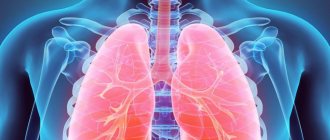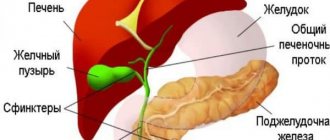Bronchopneumonia is a disease of inflammatory and infectious origin that affects the pulmonary apparatus. The development of bronchopneumonia occurs with the formation of loci of inflammation of a small-focal and large-focal nature, localized by location in the structural units of the lung tissue structure - lobules. Depending on the affected area, the lesion can be single or multiple in nature; right-sided bronchopneumonia and left-sided bronchopneumonia are also distinguishable.
Acute bronchopneumonia most often manifests itself by a mechanism of longitudinal spread with successive involvement of increasingly larger volumetric areas in the process, starting its damage from the terminal bronchi, then involving further bronchioles and ending with the alveolar ducts. And, very sporadically encountered, also in practical activities, the transverse or so-called peribronchial path. The favorite site for localizing the disease, acute bronchopneumonia, in most cases, is the lower segments of the lung, and damage to the apical lobes is considered atypical.
Acute bronchopneumonia , relative to the number of other subtypes of inflammatory lung pathology, occupies a leading position, accounting for almost half of all cases diagnosed in medical practice, but at the same time, bronchopneumonia progresses quite slowly, develops and the symptom complex of the disease is often quite blurred, blurred, has a great variety of manifestations, duplicates and is masked for other respiratory diseases. Therefore, when conducting a survey based on anamnestic data, the patient will often not be able to accurately indicate the time period of onset of the disease.
Bronchopneumonia in children is still somewhat different from the adult cohort of the population, appearing rather as a consequence of even minor viral infectious lesions, that is, uncomplicated pathologies and, often quite the same, after illness with the flu. Also, in children the primary development of the lesion is not typical, but in the older group it is just the opposite - it appears as an independent primary developed disorder. Pathogenetic phenomena in childhood are explained by the accumulation of exudative fluid, which is localized in the alveolar sacs, which complicates the normal breathing process. Alveolar exudate, in most studies, has been proven to be serous content with a slight admixture of leukocytes and epithelial cells.
Bronchopneumonia with hemorrhagic manifestations can occur in isolated situations, since the process of damage to the walls of blood vessels is not clearly expressed, therefore, bleeding during coughing is not typical and not typical for this pathology. With excessive activity of pathogenic microflora, which is located in places where sputum accumulates, pulmonary edema can form, which will lead to further inflammation. But, unlike the older population, in children the lesions are often single and do not exceed a range of more than 1 cm in diameter.
Usually, the etiopathophysiological process of bronchopneumonia is completely resolved safely, however, in advanced cases, a transition to chronicity and severe nosological manifestations with the development of gangrenous changes and abscess formation is possible.
Symptoms
Bronchopneumonia has various clinical manifestations. Clinical symptoms include:
- hyperthermia;
- weakness;
- cough;
- dyspnea;
- chest pain;
- tachycardia
The increase in body temperature ranges from 38-39 degrees. In this case, the body undoubtedly fights the disease. Weakness may be accompanied by decreased appetite. A person may experience chills and sweating. What is a reliable symptom of general intoxication. The cough is characterized by progression. First it is dry, then wet. The sputum may be streaked with blood.
Shortness of breath may not necessarily occur with physical exertion. At rest, the patient may feel shortness of breath. The chest pain is quite severe. Usually there is pain when inhaling or when coughing. Tachycardia is quite noticeable. The pulse rate increases to 110 or more beats per minute.
go to top
Complications of bronchopneumonia
Late diagnosis, inappropriate or suboptimal treatment, or the presence of particularly aggressive pathogens (or those characterized by antibiotic resistance) or favorable clinical conditions are all factors that may predispose to the development of complications; Among the most common:
- sepsis
- pleurisy
- lung abscess
- respiratory failure
- heart failure
Sepsis is the most serious complication because it is associated with a general infection of the body due to the penetration of pathogenic microorganisms into the blood. Immediate medical attention is required because severe symptoms may develop, including:
- high body temperature
- severe chills
- tachycardia
- tachypnea
- hypotension (low blood pressure)
- confusion
- pallor
- loss of consciousness
In the absence of medical attention, this can be fatal.
Diagnostics
In the diagnosis of bronchopneumonia, the following studies are distinguished:
- taking anamnesis;
- complaints:
- visual inspection;
- heart rate measurement;
- auscultation;
- listening to the lungs;
- radiography;
- microbiological examination of sputum;
- tomography
Taking anamnesis is a widely used test. It will help identify the disease at an early stage. The doctor collects all information regarding this disease. Visual inspection involves tapping and listening for wheezing. Usually, with the disease, body temperature rises and tachycardia is observed.
Using a special medical device, the lungs are listened to. With bronchopneumonia, wheezing and noises are heard. However, this is a low-power study.
X-ray is the most common method for suspected bronchopneumonia.
To determine the causative agent of bronchopneumonia, microbiological examination of sputum is used. It is known that the causative agent of the disease is streptococcus or pneumococcus.
Tomographic studies can provide a more comprehensive picture of the disease. Tomography is also widely used in diagnosing the disease.
go to top
Kinds
There are several types of this disease:
X-ray of the lungs with bronchopneumonia
Prevention
Bronchopneumonia, like any other disease, can be prevented. Prevention will consist of lifestyle modifications. It is necessary to give up bad habits.
If there are diseases of the upper respiratory tract, it is important to treat them at the initial stage. Avoid direct contact with a carrier of the virus.
Strengthening your immune system will help you cope with the disease. Bronchopneumonia is also a consequence of immunodeficiency. Therefore, taking vitamins, hardening, a healthy lifestyle. And, of course, playing sports.
A healthy diet is of great importance. The daily diet should provide the body with all the necessary ingredients. In the presence of concomitant diseases, it is important to carry out therapeutic therapy in a timely manner. Let's say heart disease requires complex treatment. Diabetes mellitus also requires constant treatment.
go to top
Is bronchopneumonia contagious?
In general, bronchopneumonia is not considered a contagious disease except in very special cases (such as tuberculosis) and/or affecting immunosuppressed patients; caused by bacteria and viruses, however, exposure to infected secretions can cause the development of other respiratory infections.
In fact, viral pneumonia can be caused by the same viruses that are responsible for the flu and colds . Therefore, the virus that causes the disease is contagious, but bronchopneumonia is not.
In adults
Bronchopneumonia develops mainly in older people. Due to various complications. Including chronic diseases and diabetes. Bronchopneumonia in adults may be accompanied by diseases of the cardiovascular system.
The causative agents of bronchopneumonia can be pneumococci, staphylococci and streptococci. The disease can spread in one lobe of the bronchus, or it can affect two bronchi at once. The cause of the disease in older people may be complications resulting from any interventions. This could be surgery.
There are two forms of the disease in adults. These include:
- regular form;
- toxic form
The usual form is characterized by reactions from the body. It manifests itself from the first days of the disease. The temperature is from 38 to 39 degrees. The toxic form is accompanied by intoxication of the entire body. It appears acutely. Pulmonary edema may develop. In this case, death is possible.
go to top
The main signs of bronchopneumonia, and features in the diagnosis and treatment of the disease
Bronchopneumonia is one of the many types of pneumonia, and is characterized by an inflammatory process in the tissues of the lungs.
It requires timely diagnosis and treatment, as it can lead to serious complications and disruption of the respiratory system.
In detail, what is it, how to recognize the symptoms of bronchopneumonia, how does it differ from ordinary pneumonia, is this form of the disease contagious or not, what is the diagnosis and treatment of the disease in adults and children?
Characteristics
The inflammatory process in bronchopneumonia affects the walls of the bronchioles - the terminal branches of the bronchial tree, and gradually spreads to the lungs. The alveoli (small vesicles that make up the respiratory organs) become filled with purulent exudate, which causes the corresponding symptoms.
The difference, unlike classic pneumonia, which is characterized by extensive tissue damage, in this pathology the foci of inflammation are small, about 2-4 mm in diameter - they are located separately from each other, or merge together.
In the international classification of diseases ICD-10, bronchopneumonia was assigned code J.18.0.
The causative agents of the disease are viruses and bacteria that multiply in the tissues of the lungs - staphylococci, pneumococci, E. coli, etc. It can act either as an independent disease or as a complication of other respiratory tract pathologies - bronchitis, catarrh, ARVI, influenza, tracheitis.
At risk are children under 3 years of age and elderly people over 65 years of age, especially bedridden patients whose normal blood circulation in the respiratory system is impaired, and those who suffer from diabetes, cardiovascular disorders, and immunodeficiency conditions.
More rare causes of bronchopneumonia include prolonged inhalation of foreign bodies and toxic substances, and stay on a ventilator.
This type of pneumonia is contagious and is transmitted by airborne droplets even with minor contact with a carrier of the disease.
IMPORTANT! In smokers and people who abuse alcohol, bronchopneumonia is diagnosed several times more often than in other cases.
Forms and varieties in adults and children
Bronchopneumonia is classified according to several criteria - the type of pathogen, the nature of the clinical course and the localization of the pathological process, and each type of disease has its own symptoms and characteristics in adults and children.
Depending on the characteristics of the course, the disease can be acute or chronic. In the first case, the pathology develops quickly and is manifested by severe symptoms - fever, chills, cough. If left untreated, the acute form develops into a chronic form, which is characterized by frequent relapses and serious complications.
Based on the location and characteristics of the inflammatory process, bronchopneumonia is divided into several types - right-sided, left-sided, bilateral, focal, etc.
- Right-handed. The causative agents of the disease (usually streptococci) enter the lower left part of the lungs and accumulate there, causing inflammation and poor circulation in the bronchi.
- Left-handed. This form of bronchopneumonia most often manifests itself as a complication after respiratory infections, and is the most dangerous for the patient. Usually the disease begins with pronounced symptoms, but sometimes there may be no signs in the first stages.
- Lower lobe. The pathological process affects the pleura, as well as one or both lobes of the lungs, most often on the right side. It begins suddenly, with a sharp deterioration in health, and occurs in an acute form.
- Double sided. Double pneumonia is caused by frequent colds, weakened immunity, and deficiency of vitamins and microelements. It affects both lungs and significantly impedes the normal functioning of the respiratory system.
- Polysegmental. Lesions are observed in several segments of the lungs at once, which is why the disease is severe and requires complex therapy.
- Focal. The inflammatory process involves small areas of tissue within the boundaries of one part of the respiratory organs. Most often it acts as a complication of bronchitis, and in most cases responds well to conservative therapy.
- Purulent. In this form of the disease, destruction of the lung tissue occurs with the formation of ulcers. In addition to the general symptoms of respiratory infections, with purulent bronchopneumonia the patient experiences severe weight loss, including exhaustion.
- Catarrhal. A type of disease that occurs only in animals and is not dangerous to humans. It begins with an inflammatory process in the bronchi, which eventually spreads to the lung tissue.
Viral forms of the disease with limited lesions occur most easily, but at the same time, due to the unclear clinical picture, they are difficult to diagnose.
IMPORTANT! Severe forms of bronchopneumonia often develop in people receiving inpatient treatment in medical institutions - they are caused by viruses and bacteria that have developed resistance to antibiotics.
Symptoms
Bronchopneumonia, as a rule, begins acutely, and the patient’s condition worsens within just a few hours. Symptoms of the disease include:
- an increase in temperature to 38-39 degrees, but in some cases a prolonged low-grade fever (37-37.5 degrees) may be observed;
- cough, first wet, and then with copious sputum, which may contain impurities of pus and blood;
- respiratory dysfunction (rapid or confused breathing);
- chest pain, localized in the area of the lesion and manifested by deep breaths and coughing;
- serious deterioration in general health - weakness, chills, sweating, pale skin, severe headache;
- in severe cases, hallucinations, delirium, and loss of consciousness are possible.
The severity of manifestations depends on the clinical course of the disease and the condition of the patient’s body, and some forms of bronchopneumonia in the initial stages are asymptomatic .
How is it diagnosed?
Making a diagnosis of bronchopneumonia begins with an external examination of the patient, measuring vital signs, collecting complaints and anamnesis, after which a number of clinical and instrumental diagnostic methods are used.
- Tapping. When tapping the skin over the lungs during bronchopneumonia, a characteristic short, booming sound is heard.
- Listening (auscultation) of the lungs. When listening to the chest with a stethoscope, fine rales, noises and a decrease in the respiratory rhythm are heard.
- Blood and urine tests. In a general blood test, an increase in the level of leukocytes and an increase in ESR are observed, which indicates inflammation in the body. In the urine of bronchopneumonia, indicators of the infectious process are determined - traces of protein and red blood cells.
- X-ray. The most informative way to diagnose bronchopneumonia is that the images show characteristic areas of darkening, increased pulmonary pattern and other changes.
- Sputum analysis. Sputum examination is carried out to identify the causative agent of the disease and its sensitivity to antibiotics.
Differential diagnosis for bronchopneumonia is carried out with classic pneumonia, bronchitis, pleurisy and other acute diseases of the respiratory system.
IMPORTANT! If left untreated, bronchopneumonia causes severe complications, including serious damage to the lungs, kidneys and heart, and in some cases can be fatal.
Healing Methods
For mild cases of bronchopneumonia, therapy at home is possible, but patients with severe forms must be hospitalized in a hospital. Patients need bed rest, plenty of warm drinks, and a diet high in nutrients and vitamins.
Dishes should be nutritious, easily digestible and natural (dairy products, white meat, vegetables and fruits), and pickled, salted, smoked foods, processed foods and alcohol should be avoided.
The basis of treatment is antimicrobial agents, which are taken orally, administered intramuscularly or intravenously, and the choice of drugs depends on the causative agent of the disease - sulfonamides and broad-spectrum drugs are most often used. Along with antibiotics, expectorants (mostly of herbal origin), antipyretic and antispasmodic medications are prescribed.
Sometimes antibiotic therapy is combined with antihistamines, antivirals and immunostimulating medications. After normalization of temperature and general condition, patients are shown physiotherapeutic procedures (mustard plasters, electrophoresis, inhalations) and physical therapy.
IMPORTANT! Treatment of bronchopneumonia with folk remedies is possible only as an addition to antibiotics and other drugs prescribed by a doctor.
Prevention
To quickly restore the body and prevent relapses of bronchopneumonia, it is recommended to quit smoking, lead a healthy lifestyle, get proper rest and eat right. During the cold season, you should avoid hypothermia, places with large crowds of people, wash your hands as often as possible and gargle with decoctions of medicinal herbs or antiseptic solutions.
As a preventive measure, you should take vitamin complexes, and if there are no contraindications, get a flu shot, since infectious diseases of the respiratory tract most often cause the development of bronchopneumonia.
Check out visually about bronchopneumonia in the video below:
Bronchopneumonia can cause serious problems in the body, so when the first symptoms appear, you should consult a doctor as soon as possible. With timely diagnosis and the correct approach to treatment, it responds well to conservative therapy, and compliance with preventive measures helps to avoid consequences and relapses of the disease in the future.
Source: https://med-kurator.com/organy-dyhaniya/pnevmoniya/bronhopnevmoniya.html
In children
Most often, bronchopneumonia in children is caused by the introduction of pneumococci. The disease develops in young children. The course of the disease is quite severe.
The disease may be a consequence of colds. These include: influenza. And also a consequence of infectious diseases such as measles and whooping cough.
Lack of timely treatment of the underlying disease can lead to bronchopneumonia. Also a predisposing factor to the disease is a decrease in the body’s immune defense.
For newborn children, the situation is more complicated. Than in older children. If left untreated for the first few days of illness, bronchopneumonia can progress to a more serious stage.
go to top
Causes of bronchopneumonia
Bronchopneumonia can be of infectious or non-infectious origin.
Infectious pathogens include:
- bacteria (bacterial bronchopneumonia)
- viruses (viral bronchopneumonia)
- fungi (fungal bronchopneumonia)
The most responsible microorganisms are:
- pneumococci
- staphylococci
- streptococci
- gram-negative microbes (Klebsiella pneumoniae, Pseudomonas aeruginosa, Escherichia coli, Serratia marcescens, Haemophilus influenza, Legionella Pneumophila)
- mycoplasma
- influenza A and B viruses
- adenovirus
- syncytial virus
- measles virus
- varicella zoster virus
- rubella virus
- chlamydia
- protozoa
- and etc.
Infection often occurs during hospitalization associated with other pathologies, which is facilitated primarily by a long hospital stay; in these cases we will talk about nosocomial infection.
Non-infectious pathogens include chemical, physical and environmental agents, in particular:
- radiation
- harmful gases
- mineral oils
- acids
- irritating chemicals
- air and environmental pollutants
- gastric acid or ingestion of foreign material or food into the bronchial tree
- severe chronic diseases
- complication of lung surgery
Bronchopneumonia causes inflammation with multiple foci in one or both lungs (which is why we talk about bronchopneumonia or lobular pneumonia), in contrast to lobar pneumonia, which tends to affect only one lobe of the lung.
The inflammation is caused by an infection caused by a pathogen that has reached the bronchioles, alveoli and pulmonary spaces, usually through the air. Sometimes the infection is transmitted through the lymphatic system or blood (for example, if you have an ongoing illness such as measles, whooping cough or influenza, then bronchopneumonia is actually a complication).
Inflammation, regardless of the responsible pathogen and mode of transmission, will always cause:
- purulent exudate
- swelling of the walls of the alveoli and respiratory bronchioles
- obliteration of pulmonary berries filled with exudate
with subsequent obstruction of air flow and gas exchange (oxygen/carbon dioxide) between the lungs and blood. That is, difficulty breathing in a more or less serious form.
Treatment
It is better to carry out therapeutic therapy in a hospital setting. Directly under the supervision of medical personnel. The doctor should prescribe bed rest and plenty of fluids. What is important in the treatment of bronchopneumonia.
Certain dietary conditions must also be observed. Food should be mechanically gentle. It is important to reduce the amount of table salt in food. Try to use it less.
Physiotherapy is the most important measure in the treatment of this disease. Electrical currents such as electrophoresis may be used. Mustard plasters and medicinal mud are also used in medical therapy. Drug treatment is also used. Antibacterial drugs: penicillins.
Drugs that increase the body's protective properties: ginseng. Mucolytic drugs that promote expectoration of sputum. For example, thermopsis.
go to top
Forecast
Bronchopneumonia is predicted both favorably and unfavorably. It depends on the age of the patient, the pathogen and other concomitant diseases. Community-acquired bronchopneumonia can be fatal. The prognosis is largely determined by the severity of the disease. The more severe the course of the disease, the worse the prognosis. This means that complications including aspiration of the respiratory tract are possible.
A favorable prognosis is also possible. But everything depends on the treatment. Also a pathogen. Timely treatment improves the prognosis of the disease.
go to top
Pneumonia and bronchopneumonia. What is the difference
How is pneumonia different from bronchopneumonia? Pneumonia, especially bilateral, is characterized by more extensive damage to the lung tissue
compared to bronchopneumonia, which is characterized by small lesions, about 2-4 mm.
Diagnosis of bronchopneumonia is difficult due to the small size of the lesions.
Main signs of the disease:
- A sharp increase in temperature, up to 38-39
- Cough, first dry, then with copious sputum production
- General weakness, fatigue
- Pale skin
- Wheezing in the lungs and bronchi
Complications due to late diagnosis
With neglected treatment, in particular, in the absence of antibiotics, the lesions may merge with each other and the development of complicated, severe forms of the disease. Complications of the course of the disease are possible, such as pleurisy, acute respiratory failure, gangrene of the lungs, and abscessive changes.
Possible extrapulmonary complications. When the infection spreads throughout the body, complications such as meningitis, kidney inflammation, toxic shock, and damage to the heart muscle are possible.
Early diagnosis contributes to the most effective treatment and avoidance of negative prognoses. It is extremely important to start therapy as early as possible.
Exodus
Deaths are possible in 60% of cases. Bronchopneumonia may be accompanied by complications from other organs. An abscess may develop.
It is known that the suppurative process in the body also depends on the immune system. A risk factor for this is old age. Or children under 1 year old. Favorable outcomes and even cases of recovery are possible. Especially for people undergoing treatment in specialized medical institutions.
An unfavorable outcome is possible if two lobes of the bronchus are involved. And also in the presence of inflammation and cardiovascular diseases.
go to top
Classification
Depending on the location of the lung damage, viral or bacterial pneumonia can be:
- Unilateral (one lung is affected).
- Bilateral (affects both right and left lungs).
- Lobar (the inflammatory process spreads to an entire lobe, usually the lower one).
- Focal (inflammation spreads from the bronchi, affecting adjacent areas of the lung tissue). The second name is bronchopneumonia.
Depending on where the disease began to develop, the disease is classified into:
- Hospital (infection and development of the disease occurs in a medical institution). These cases are the most severe and require long-term treatment.
- Community-acquired (infection occurs outside the hospital walls).
Lifespan
As mentioned above, life expectancy will depend on several factors. If a young person falls ill, the cause of death can be severe complications. As well as a decrease in the protective properties of the body. If a comprehensive examination and adequate treatment is carried out. That life expectancy may increase. Especially if the patient is undergoing hospital treatment.
In many ways, the quality and duration of your life depends on you! Treat the disease on time, do not put yourself at risk! After all, the risk of complications will not increase your life expectancy!
Factors contributing to the occurrence of bronchopneumonia
The causes of bronchopneumonia are viruses or bacteria, most often pneumococci, streptococci and staphylococci. Their penetration into the human body and further active reproduction causes a significant increase in temperature. Sometimes the temperature does not change at all. There may be weakness or malaise. A slight but constant cough and general lethargy of the patient. Negative microorganisms that enter the bronchi and bronchioles cause inflammation and swelling of the lungs with the formation of excessive amounts of pulmonary secretion. This liquid, according to the laws of gravity, moves down and causes blockage of the lumens in the bronchi.
In adults, factors contributing to the appearance of bronchopneumonia are the following:
- passive and active smoking;
- chronic foci of infection in the mouth and nasopharynx, which contribute to inflammation and require separate immediate treatment;
- harmful working conditions;
- polluted environment.











